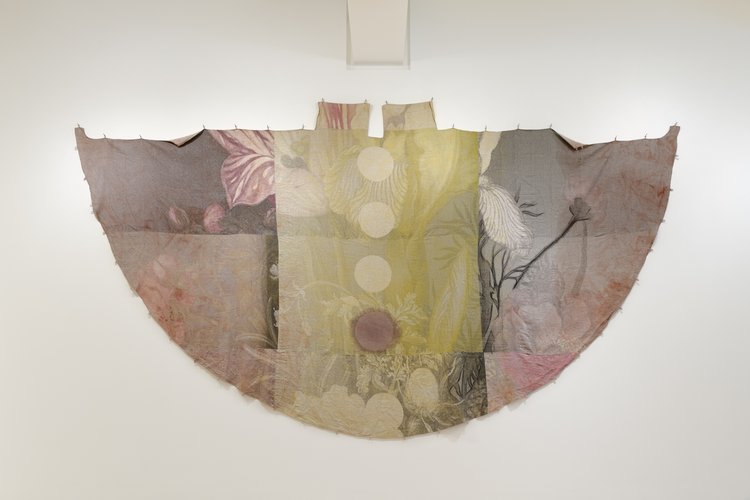This activity is developed for children ages 3 and older. Download and print this guide for easy reference.
Please note that this activity will require assistance from an adult with preparing some food items.
GET INSPIRED
Art can be made out of many different types of materials. While some artists work with materials that need to be purchased from art supply stores, some choose to create with natural materials. Omaskêko Cree artist Duane Linklater incorporated natural materials into several pieces in the exhibition Duane Linklater: mymothersside, on view at the Frye Art Museum through January 16, 2022.

can the circle be unbroken 2, 2019. Digital print on linen with iron-red dye, cypress-yellow ochre, blueberry extract, charcoal. 120 x 240 in. Commissioned by the San Francisco Museum of Modern Art, courtesy of the artist and Catriona Jeffries, Vancouver, 2020.24. Installation view from Duane Linklater: mymothersside, Frye Art Museum, Seattle, 2021. Photo: Jueqian Fang
Blueberry extract is one of the natural materials used to create the colors in this piece, entitled can the circle be unbroken 2. Can you spot where the blueberry extract is applied?
Many other colors you see in this work are applied through a dyeing process. Textile dyeing is the application of dyes or pigments onto textiles with a special solution containing dyes and other materials.
MAKE SOME ART
Inspired by Linklater’s work? The Frye collaborated with Kathy Hattori of Botanical Colors to offer a bundle dyeing activity that can easily be done at home with what you already have on hand. Follow along using the video demonstration, or read the instructions below.
You will need:
-
Either plant-based fabric, such as linen, cotton, bamboo, and hemp, or animal-based fabric, such as silk. (It could be a old t-shirt, a tote bag, or a pillowcase. Textiles containing synthetic materials might not absorb the colors as well, so be sure to use fabric with over 60% natural fibers. )
-
3-5 dyestuffs from your kitchen and/or garden, such as:
-
Purple cabbage
-
Red or yellow onion skin
-
Avocado skin
-
Coffee grounds (new or used)
-
Loose black tea leaves or tea bags (new or used)
-
Dark-colored flowers, such as hibiscus, chamomile, red or pink roses, marigolds, dahlias, or peonies (dried or fresh)
-
Eucalyptus
-
Turmeric powder (can be replaced with curry powder)
-
-
Rubber bands or twine
-
Distilled white vinegar (watered down using an approximate 1:3 ratio)
-
Spray bottle
-
Access to a stove and a steamer pot with a lid (an Instant Pot works too!)
-
Tongs
-
Iron (optional)
LET’S GET STARTED
-
Prepare to clean the fabric by soaking it in the vinegar-water solution and wringing the water out completely. Ideally, the fabric should be damp.
-
Lay your fabric flat on a surface before placing the dyestuffs over the fabric. Consider leaving some in larger pieces while breaking some down into smaller pieces. If desired, grinding them down to a powder form is an option too.
-
Lightly spray the vinegar-water solution over the fabric and dyestuffs.
-
Tightly roll the fabric up from one edge. Spray some more of the vinegar-water solution as needed in order to keep it damp. Then, roll the fabric into a circular bundle, making it look like a cinnamon bun. Secure the bundle with rubber bands or twine. Spray some more of the vinegar water solution.
-
Place the bundle in a pot to steam for approximately one hour. Using tongs, flip the bundle halfway through to ensure the bundle is evenly steamed. Alternatively, soak your fabric in the vinegar water solution for 5 to 10 minutes before placing it in a glass jar and leaving it for a week. This process omits the steaming element.
-
Let the bundle cool down before handling it. Remove the rubber bands or twine and unroll the fabric. Remove the dyestuffs.
-
Once the fabric dries, you may choose to iron the textile. Note that some colors might change and some colors will fade over time. Avoid excessive exposure to the sun. If washing is needed, use a pH-neutral soap.
SHARE YOUR WORK
Take a close look at your textile after completing the bundle dyeing process.
-
What do you notice about the colors? Which dyestuff created which color on your textile?
-
Did the colors turn out the way you were expecting? What surprised you?
-
What do you notice about the shapes and design of your textile?
-
Smell your textile. What do you smell?
We’d love to see how your bundle dyeing project turns out! Please share a photo of it on social media using the hashtag #FryefromHome.
Lynn Chou
Manager of Youth and School Programs